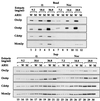Stepwise assembly of initiation proteins at budding yeast replication origins in vitro
- PMID: 11121019
- PMCID: PMC18880
- DOI: 10.1073/pnas.97.26.14115
Stepwise assembly of initiation proteins at budding yeast replication origins in vitro
Abstract
The initiation of DNA replication in the budding yeast Saccharomyces cerevisiae occurs in two sequential and mutually exclusive steps. Prereplicative complexes (pre-RCs) containing origin recognition complex (ORC), Cdc6p, and the MCM2-7 proteins assemble only under conditions of low cyclin-dependent kinase (Cdk) activity during G(1), whereas origin activation is driven by the increase in Cdk activity at the end of G(1). As a first step toward the reconstitution of this two-step process in vitro, we describe a system in which extracts prepared from G(1)-arrested cells promote sequential assembly of ORC, Cdc6p, and MCM2-7 proteins onto exogenously added origin-containing DNA. This reaction requires an intact ARS consensus sequence and requires ATP for two distinct steps. Extracts from cells arrested in mitosis also can support the binding of ORC but are unable to load either Cdc6p or MCM2-7 proteins. This system should be useful for studying the mechanism and regulation of pre-RC assembly.
Figures




Similar articles
-
Reconstitution of Saccharomyces cerevisiae prereplicative complex assembly in vitro.Genes Cells. 2006 Jul;11(7):745-56. doi: 10.1111/j.1365-2443.2006.00975.x. Genes Cells. 2006. PMID: 16824194
-
An essential role for the Cdc6 protein in forming the pre-replicative complexes of budding yeast.Nature. 1996 Jan 11;379(6561):180-2. doi: 10.1038/379180a0. Nature. 1996. PMID: 8538771
-
ORC- and Cdc6-dependent complexes at active and inactive chromosomal replication origins in Saccharomyces cerevisiae.EMBO J. 1996 Dec 2;15(23):6671-9. EMBO J. 1996. PMID: 8978693 Free PMC article.
-
Getting a grip on licensing: mechanism of stable Mcm2-7 loading onto replication origins.Mol Cell. 2006 Jan 20;21(2):143-4. doi: 10.1016/j.molcel.2006.01.003. Mol Cell. 2006. PMID: 16427002 Review.
-
Cdc6 and DNA replication: limited to humble origins.Bioessays. 1996 Nov;18(11):859-62. doi: 10.1002/bies.950181103. Bioessays. 1996. PMID: 8939063 Review.
Cited by
-
The DNA-A component of a plant geminivirus (Indian mung bean yellow mosaic virus) replicates in budding yeast cells.J Virol. 2004 Mar;78(5):2405-13. doi: 10.1128/jvi.78.5.2405-2413.2004. J Virol. 2004. PMID: 14963136 Free PMC article.
-
Biochemical characterization of Cdc6/Orc1 binding to the replication origin of the euryarchaeon Methanothermobacter thermoautotrophicus.Nucleic Acids Res. 2004 Sep 9;32(16):4821-32. doi: 10.1093/nar/gkh819. Print 2004. Nucleic Acids Res. 2004. PMID: 15358831 Free PMC article.
-
Human Mcm proteins at a replication origin during the G1 to S phase transition.Nucleic Acids Res. 2002 Oct 1;30(19):4176-85. doi: 10.1093/nar/gkf532. Nucleic Acids Res. 2002. PMID: 12364596 Free PMC article.
-
Human geminin promotes pre-RC formation and DNA replication by stabilizing CDT1 in mitosis.EMBO J. 2004 Aug 4;23(15):3122-32. doi: 10.1038/sj.emboj.7600314. Epub 2004 Jul 15. EMBO J. 2004. PMID: 15257290 Free PMC article.
-
Atomic force microscopic analysis of the binding of the Schizosaccharomyces pombe origin recognition complex and the spOrc4 protein with origin DNA.Proc Natl Acad Sci U S A. 2004 Dec 28;101(52):17952-7. doi: 10.1073/pnas.0408369102. Epub 2004 Dec 14. Proc Natl Acad Sci U S A. 2004. PMID: 15598736 Free PMC article.
References
Publication types
MeSH terms
Substances
LinkOut - more resources
Full Text Sources
Molecular Biology Databases
Research Materials
Miscellaneous

